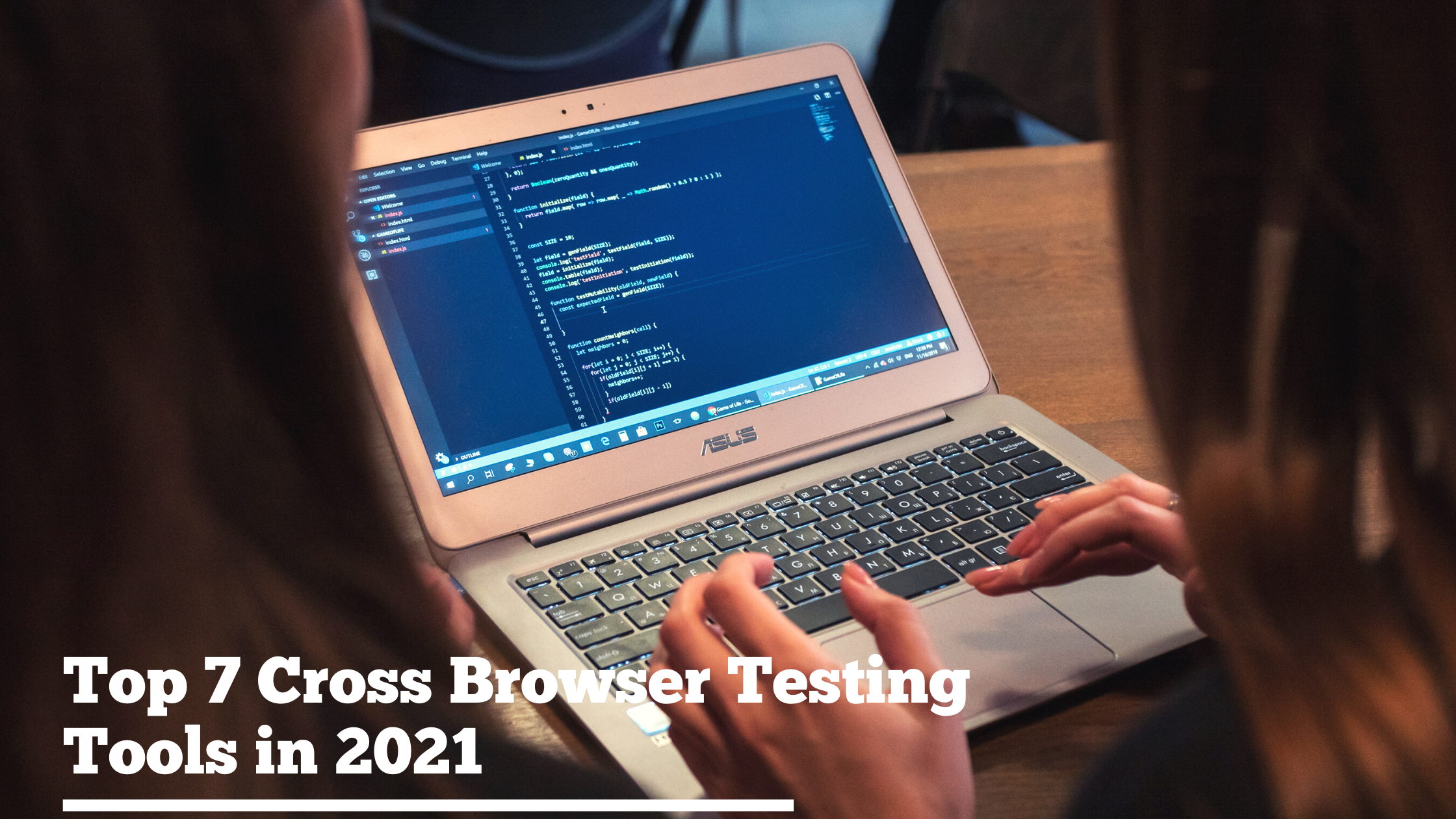Top 7 Cross Browser Testing Tools in 2021
Join the DZone community and get the full member experience.
Join For Free
In today’s fast-paced market, web apps run on several browsers (Edge, Firefox, Google Chrome, Safari, etc.) on varied desktop or mobile devices with particular screen settings. This is the reason why we need to execute cross-browser tests. Cross Browser Testing scrutinizes the compatibility of a website or web apps on varied operating systems, devices, and browsers. Through Cross-browser Tests we ensure that the website or web app works smoothly and uniformly on the devices and browsers that your client may use -
• Devices - Laptop, Mobile, tablet, smart TV, desktop, etc.
• Operating Systems - macOS, iOS, Android, Windows, etc.
• Browsers - Firefox, Chrome, Safari, Edge, Internet Explorer, Opera, UC Browser, etc.
Any user might be using any of the gadgets with any blend of Operating System or browser. Hence, it is required to ensure the performance, compatibility, and User Interface of the app on all these combinations. When meticulously tested across all combos - cross-browser test assists to provide a high-quality and consistent user experience amid every single browser and device that your users use.
Usually, organizations follow Google Analytics or various web analytics track software to collect data like how their users are using their site. You can get updated usage and check this Wikipedia URL usage share of web browsers globally
Usage share of all browsers as of Nov’ 2018
• Google Chrome: 61.75 percent
• Safari: 15.12 percent
• Mozilla Firefox: 4.92 percent
• UC: 4.22 percent
• Opera: 3.15 percent
• IE: 2.8 percent
• Samsung Internet: 2.74 percent
• Microsoft Edge: 2.15 percent
• Others: 3.16 percent
Why Is Cross-Browser Testing Required?
An app or website comprises CSS, HTML, and JavaScript elements. We don’t know over which browser our user might see our app. We know that every single browser has its restrictions, capacities, and technology. As every single browser interprets an app in its own means, this results in distinct outcomes for different users.
We must sure that when rendered on distinct browsers the final outcome should be similar for all users. Thus, by cross-browser tests, we confirm constancy of two things across multiple -
• The site’s display on distinct Operating System and browser combinations
• The site’s functionality on distinct Operating System and browser combinations
When Cross-Browser Tests is Done?
Depending on your workflow and role, one could be running cross-browser testing:
- In Staging/Pre-Release: Quality Assurance teams do this for each Release Candidate to ensure that no browser compatibility problems pop up in the newest version of the site.
- During Development: Software developers in CI (Continuous Integration) pipelines test the newest traits to ensure they are cross-browser compatible prior to pushing the modifications to production.
Cross-Browser Tests Checklist
Pre-conditions for such tests:
We have to ensure the below conditions are met before commencing this type of testing:
• Prepare a cross-browser tests strategy- Which browsers (as well as their versions) will be used, which devices and operating systems will be used. What all combos will be tested?
• Define the tests’ scope - How many tests will be performed and the deadline for tests?
• Choose the correct test tool- Select the perfect automated cross-browser test tool from the accessible ones. While choosing we may ask queries such as-
• Does it incorporate third-party tools?
• Does it support parallel tests?
• Does it carry out both visual and functional tests?
• How many operating systems and browsers the automated tools support?
• Does the tool offer good technical support?
• Does its pricing meet up the budget?
7 Best Cross-Browsing Testing Tools to Look Out in 2021
When we need to test our app on varied browsers, we have cross-browser test tools. Such tools can assist us to make certain that our web app is working properly across different browsers. This tool can take place when both client-side and server-side are accessing the web app in varied web browsers. With the assistance of these tools, we can execute compatibility tests through several browsers for our app. At times, testing software in a single web-browser isn’t adequate; that is why we require the cross-browsers test tools.
Following is a curated list of top and the most popular cross-browser test tools with great features and the newest download links. The list comprises both free cross-browser paid (commercial) tools and test (open source) software.
1. BrowserStack

With instant access to around two thousands web browsers running on actual iOS and Android machines, the famous BrowserStack allows developers, as well as other stakeholders, involved in the cross-browser test, whether that is to debug glitches in realtime, take some screenshots, or really interrelate with the browser natively and check how the blueprint fairs when the window is resized. There is no requirement to compromise on emulators and simulators; this special tool provides you complete control as you can easily interact with actual browsers on remote machines.
Key Features:
• This test tool test with real browsers on actual machines that let both software developer and tester for testing sites and mobile applications
• With this special tool, you can conduct live tests and automation testing on web-browsers and mobile devices. It supports Windows (XP, 7, and 8), opera mobile, lion and mountain lion, Android, OSX snow leopard, iOS, etc.
• BrowserStack is cloud-based and so it does not require any set-up or installation, the pre-installed developer tools are useful for rapid debugging & cross-browser testing.
• Another great trait is the native experience, wherein one could enjoy testing through the web-browsers with the aid of DevTools
2. LambdaTest

This amazing cross-browser test tool is a cloud-based platform that aids you to carry out cross-browser compatibility tests of your websites or web applications. You can execute automated selenium scripts on its scalable cloud-based grid or can carry out live interactive tests on actual browser environs.
Key Features:
• Run Selenium automation tests on a scalable Selenium grid having 2000+ browser environments
• Execute automated responsive and screenshot tests of your site
• Test your privately or locally hosted site using SSH Tunnel
• One-click bug logging to your preferred tool such as BitBucket, Asana, JIRA, GitHub, Microsoft VSTS, Trello, Slack, etc.
3. TestComplete

Automation browser tests process for browser compatibility checks on different configurations and operating systems. Select from multiple programming languages like Python and JavaScript, or use its script-free Record and Replay attribute to easily generate automated UI testing.
Key Features:
• It is a User Interface functional test automated test tool that you can use for creating and running testing on any web app
• Perform testing in parallel across two thousand + real environments, all with no configuration or setup
• Grab real-time access to the newest devices, browsers, resolutions, and operating systems in its device cloud

It is one of the most popular licensed tools. Cross-browser testing supports several OSs, a 1000 amalgamation of OSs, multiple browsers, including mobile browsers, and their versions. The additional trait comprises the localhost support, automated screenshot, and so on. It is a popular commercial cross-browser tests tool.
Key Features:
• The tool offers interactive browser compatibility testing over the desktop as well as mobile. It is accessible for multiple Operating Systems
• Their key attribute comprises visual tests (screenshots) live tests (manual tests), and automation tests. This makes a perfect platform for QA, developers, and designers, to team up on test projects
• Cross-browser tests have localhost support, automated screenshot traits, and test behind logins amongst others
5. Selenium Box

It is an Enterprise Selenium Grid that performs on-premises or in the corporate cloud, is highly scalable and completely managed. It lets execution of automation testing for mobile and web inside the corporate firewall. It is well-designed for big-giants in security susceptible areas like the medical, insurance, and banking field. This amazing tool combines the traits of SaaS solutions with the safety and performance of in-house/ on-prem deployment.
Key Features:
• Highly scalable
• Corporate or on-premises cloud deployment
• Desktop browsers, simulators or emulators, and actual devices
• Protected, no external or tunnels access required
• Maintenance-free and fully managed
• Enterprise integrations e.g. CROWD, LDAP
6. GhostLab

This incredible tool is used for testing our app on any site on various browsers and mobile devices simultaneously. With the aid of this tool, we can unlock our locally installed browsers straight, and for connecting a mobile device; we can make use of the near QR code. GhostLab also supports us to develop our websites when we are working on a local website. It is accessible for both Mac and Windows OSs with no additional configuration or setup.
Key Features:
• This tool can easily take the screenshot of any connected gadget, and describe it in the joined editor, plus also drag & drop it to our bug tracker
• Offer synchronized browsing
• Assist us to debug the JavaScript with any connected users
• Confirms the DOM and CSS on any gadgets, if any alterations occur in DOM, it will automatically modify in all linked devices
• It can restore all our browsers at any time we make any alterations to the local files
• Within a click, we can build & open several browsers and connect them to this precise tool
7. Sauce Labs

It is a cloud-based app tests platform that provides its services to companies and open-source developing teams. It provides both manual and automated tests of mobile and web apps for more than 800 mobile devices (Android and iOS) and browser platforms.
Key Features:
• Live Tests & Automated Tests
• Immediate access to 200+ mobile simulators & emulators
• Instant access to 800+ OS & desktop browser combos
• Immediate access to actual mobile devices
Other Browser Testing Tools:
1. Browsershots
2. Ranorex Studio
3. IE NetRenderer
4. TestingBot
5. IE Tab
6. Smartbear TestComplete
7. Applitools
8. Datadog
9. Turbo Browser Sandbox
10. Experitest
Final Verdict
Picking out the right cross-platform testing tool often depends on your necessities as each of these browser compatibility tests tools come with their own flaws and strengths. Furthermore, choosing the best cross-browser tests tool is merely the first step in an enterprises’ test automation procedure. The next challenge that several companies face these days is to build an automated test framework that can leverage the chosen cross-platform testing service and provide optimum ROI.
Opinions expressed by DZone contributors are their own.

Comments